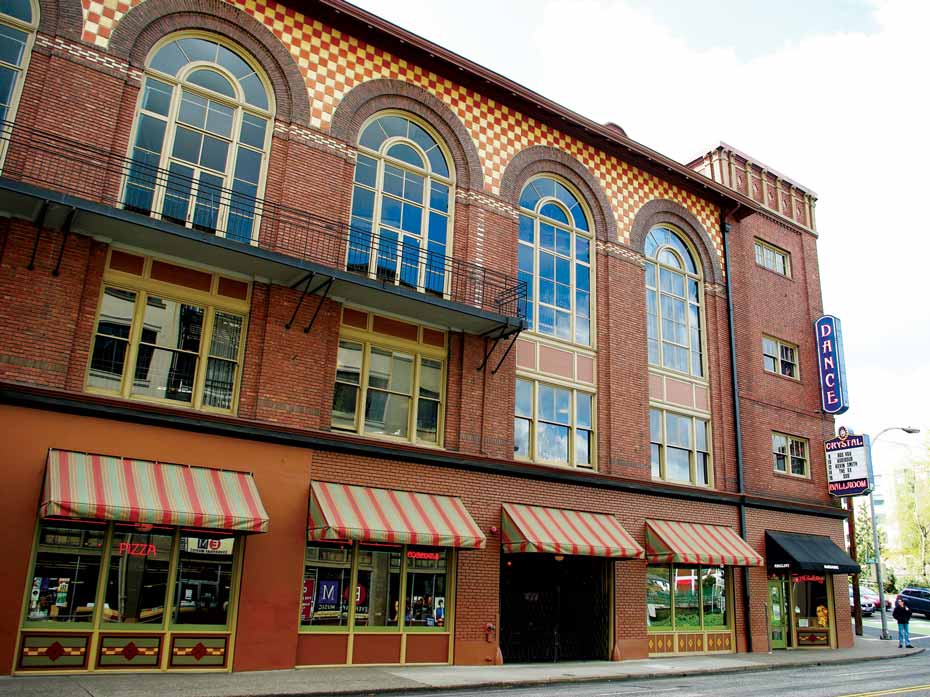Know Your Venue – The Crystal Ballroom


Though the Crystal Ballroom may not be the largest capacity venue in Portland, it is, by far, one of the most beautiful and storied structures living in this city. Since 1997, under the stewardship of McMenamins, it has become an institution that has hosted every sort of event from Patti Smith, to MusicfestNW, to the National Beard and Mustache Championships. By no means did its history start a mere 18 years ago, in fact the boards of the Crystal have played host to millions of feet stomping, fox trotting, and gliding about it’s floating floor since 1914.
At 21 years old, Michael “Montrose” Ringler, left the midwest to become the physical director for Portland’s YMCA in 1897. Bringing with him new sports from the east like basketball, Ringler was a fixture in the Portland athletic community and developed a great passion for the dance craze that was seizing the nation at the turn of the century. Eventually becoming renown as the finest dance instructor in Oregon, Ringler opened his own school, Ringler’s Dancing Academy, on the third floor of the building at 14th and West Burnside in 1914.
The light, airy ballroom was named the Cotillion Dancehall. Designed to transport dancers away from the hustle and bustle of the streets below, everything about the room was meant to create a sense of escape, like you were literally floating stories above the streets. In addition to the murals depicting gardens and meadows, lofty, skylit ceilings, expansive mirrors, and arching windows, the weightless feeling was best achieved by the floating floor. A new innovation at the time, the mechanism consisted of a series of rockers to which ball bearings were attached under the beautiful maple floor. The result was a fluid, up-and-down movement, which could be adjusted by a set of gears to accommodate different dance styles.

From the moment the doors opened, the Cotillion was a popular venue to exhibit the most popular and controversial dance: the tango. Much to the chagrin of local authorities, young dancers flocked to the Cotillion to experience the golden times of the Jazz era, until the popular music came under heavy persecution in Portland during the mid- 20’s. This took it’s toll on Ringler, and he was forced to sell to “Dad” Watson, who converted the Jazz hall into a venue for the more wholesome Square Dance.
Cotillion Hall was renamed The Crystal Ballroom in 1930’s by Ralph Farrier, who purchased the venue after Watson’s death. The Crystal remained a home for Square Dances for many years, until the venue’s fate took a much more interesting turn in the 1960’s when it became a regular stop on the West Coast R&B circuit. Great acts such as James Brown, and Ike & Tina Turner were ushered in by Charles Sullivan, who also controlled the lease on San Francisco’s Fillmore Auditorium, and booked shows up and down the West Coast.
The building of the freeway (now I-405) in the mid 60’s crippled the once thriving neighborhood and the Crystal Ballroom experienced it’s first year of vacancy from 1955-1956. Thankfully, the counter culture movement that had started in San Francisco had extended north, making the Crystal a perfect venue to host the likes of the Grateful Dead (twice!), Buffalo Springfield (with Neil Young and Stephen Stills) and hundreds of others from 1967-1968.
Following that short stint of Rock & Roll royalty, the Crystal was left dormant from 1968-1997. Though no one officially rented the space, the Ballroom became a squatting studio for local artists, and a home for mysterious and legendary parties. Because of the lack of official tenants, these years of history are mostly lost to rumor and fable.
Revived by McMenamins in 1997, the Crystal was returned to her former glory and has continued her legacy as a key Portland music venue. There are not enough words left in this article to state every major band that has taken the stage at the Crystal; just fill in everyone between Elliot Smith, Vanilla Ice, and Arcade Fire, and that should get you close to understanding the immense importance of this historic landmark. »
– Bex Silver



